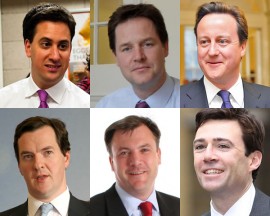
A common contemporary complaint is that British politicians are now all too similar. There is not enough diversity at the top. (See, for example, “The fall of the meritocracy” by Andrew Neil in the Spectator.)
Andrew Neil sought to criticise the narrow educational background of our current political leaders, comparing it unfavourably with the recent past.
And there is something in it. Among the members of the cabinet, 12 went to Oxford and a further 6 to Cambridge. For Labour, the five contenders for the leadership last summer all went to either Oxford or Cambridge and four of them had served as special advisers before entering parliament. (The fifth, also the only female and the only black candidate, only made it onto the ballot paper with the explicit permission of one of the other four.) And the Liberal Democrats were presented in their last leadership election with the choice between Nick Clegg (Westminster school and Cambridge) or Chris Huhne (Westminster school and Oxford).
But should we be surprised? After all, think about mass market cars. They are all rather similar these days. The picture below shows the Vauxhall Corsa, Toyota Yaris, Volkswagen Polo and Ford Fiesta. Can you tell them apart?

These cars are all so similar because they are all designed to appeal to the same audience. They make the same kind of journeys with the same number of passengers and the same amount of luggage, they drive on the same roads and face the same air resistance, they are all inspired by the same market research. Frankly, the surprise is that they are not more similar than they already are.
And as with super-minis, so with politicians. Many of them worked in the penumbra of politics before being elected – working as special advisers, lobbyists or campaigners – giving them relevant and useful professional skills. Market research is used not only by car manufacturers but by political parties: both policies and candidates are chosen not merely for their ideological conformity but also because they appeal to the voters. And Britain’s First Past The Post electoral system ensures that only a few voters, in the marginal constituencies, cast the votes that really matter in determining the outcome of the election.
Most voters live in safe seats and so have comparatively little say in choosing who forms the government. These people are the equivalent, in the eyes of vehicle manufacturers, of those who are too poor to have their own car. The product is tailored to its audience. If the electoral system concentrates influence in a few hands rather than spreads it out evenly among the population, then the successful candidates will be those that appeal to those few with influence. And the loss of diversity is the inevitable price.
